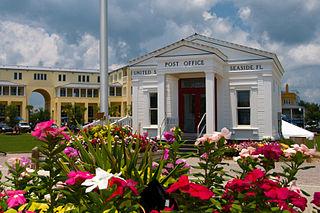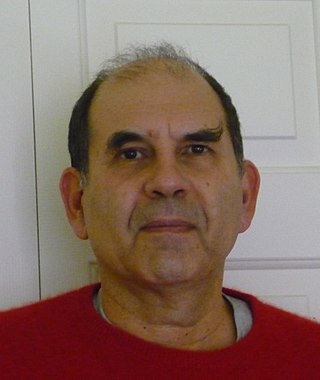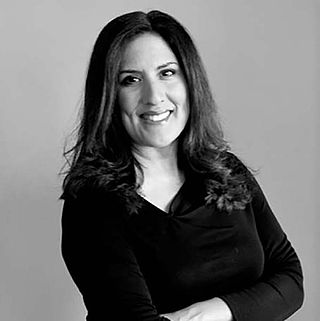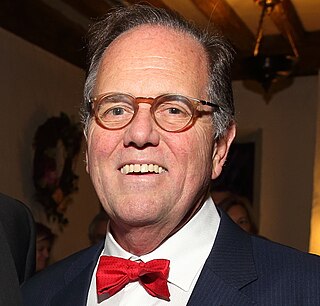
Christopher Wolfgang John Alexander was an Austrian-born British-American architect and design theorist. He was an emeritus professor at the University of California, Berkeley. His theories about the nature of human-centered design have affected fields beyond architecture, including urban design, software, and sociology. Alexander designed and personally built over 100 buildings, both as an architect and a general contractor.

New Urbanism is an urban design movement that promotes environmentally friendly habits by creating walkable neighbourhoods containing a wide range of housing and job types. It arose in the United States in the early 1980s, and has gradually influenced many aspects of real estate development, urban planning, and municipal land-use strategies. New Urbanism attempts to address the ills associated with urban sprawl and post-Second World War suburban development.

Yasmeen Lari is Pakistan's first female architect. She is best known for her involvement in the intersection of architecture and social justice. Since her official retirement from architectural practice in 2000, her UN-recognized NGO Heritage Foundation Pakistan has been taking on humanitarian relief work and historical conservation projects in rural villages all around Pakistan. She was awarded the prestigious Fukuoka Prize in 2016 and the RIBA's Royal Gold Medal in 2023.

Robert Arthur Morton Stern, is a New York City–based architect, educator, and author. He is the founding partner of the architecture firm, Robert A. M. Stern Architects, also known as RAMSA. From 1998 to 2016, he was the Dean of the Yale School of Architecture.

Léon Krier CVO is a Luxembourgish architect, architectural theorist, and urban planner, a prominent critic of modernist architecture and advocate of New Classical architecture and New Urbanism. Krier combines an international architecture and planning practice with writing and teaching. He is well known for his master plan for Poundbury, in Dorset, England. He is the younger brother of architect Rob Krier.

Alireza Sagharchi RIBA FRSA is a British-Iranian architect. He is an internationally renowned and leading practitioner of contemporary classical architecture and traditional urban design. During his professional career, he has been responsible for major master planning and building projects in the UK, Europe, North America and the Middle East.
The Prince's Foundation is an educational charity established in 1986 by King Charles III to teach and demonstrate in practice those principles of traditional urban design and architecture which put people and the communities of which they are part at the centre of the design process.

The University of Notre Dame School of Architecture was the first Catholic university in America to offer a degree in architecture, beginning in 1898. The School offers undergraduate and post-graduate architecture programs.

Nikos Angelos Salingaros is a mathematician and polymath known for his work on urban theory, architectural theory, complexity theory, and design philosophy. He has been a close collaborator of the architect Christopher Alexander, with whom Salingaros shares a harsh critical analysis of conventional modern architecture. Like Alexander, Salingaros has proposed an alternative theoretical approach to architecture and urbanism that is more adaptive to human needs and aspirations, and that combines rigorous scientific analysis with deep intuitive experience.

The Driehaus Architecture Prize, fully named The Richard H. Driehaus Prize at the University of Notre Dame, is a global award to honor a major contributor in the field of contemporary traditional and classical architecture. The Driehaus Prize was conceived as an alternative to the predominantly modernist Pritzker Prize.
In Mediterranean architecture, the fina is a physical space used in urban design, corresponding to the approximately 1-meter-wide public space alongside buildings. It is used to describe the placement of design items within traditional architectural elements. It also mandates public rules of behaviour for the neighbours concerning the usage and maintenance of finas in their buildings. For instance, a person has the right to use the part of the fina immediately in front of his home for the loading or unloading of his vehicle but he has no right to block it.
Arif Hasan, is a Pakistani architect, planner, activist, social researcher, and writer. He is a recipient of Hilal-i-Imtiaz, the country's second highest award for its citizens.
Richard Sammons is an architect, architectural theorist, visiting professor, and chief designer of Fairfax & Sammons Architects with offices in New York City, New York and Palm Beach, Florida. The firm has an international practice specializing in classical and traditional architecture, interior design and urban planning. Sammons was instrumental in the reemergence of classical design as a major movement in America through his designs as well as his work as an instructor at the Prince of Wales Institute in Britain in 1992-3 and as a founding member of the Institute of Classical Architecture in 1991. From 1996 to 2004, the Fairfax & Sammons office also served as the headquarters for the noted American architecture critic Henry Hope Reed Jr. (1915) and Classical America, the organization he founded in 1968. In 2013, Fairfax & Sammons received the Arthur Ross Award for Lifetime Achievement in Architecture, an award created to recognize and celebrate excellence in the classical tradition.

New Classical architecture, New Classicism or Contemporary Classical architecture is a contemporary movement in architecture that continues the practice of Classical architecture. It is sometimes considered the modern continuation of Neoclassical architecture, even though other styles might be cited as well, such as Gothic, Baroque, Renaissance or even non-Western styles – often referenced and recreated from a postmodern perspective as opposed to being strict revival styles.

Pier Carlo Bontempi is an Italian architect.

Patricia Saldaña Natke is an American architect, the founding partner and president of UrbanWorks, Ltd., a Chicago-based architecture, interiors, and urban planning firm.
Michael West Mehaffy is an urbanist, architectural theorist, urban philosopher, researcher, educator, and executive director of Sustasis Foundation, based in Portland, Oregon, USA.

Robert Adam is a Driehaus Architecture Prize winning British architect, urban designer and author, known for championing classical and traditional styles. Adam is a visiting professor at the University of Strathclyde and Design Council Expert.

Ethan Anthony is an American architect, author, and academic. As president of Cram and Ferguson Architects LLC, Anthony focuses on the design of the new Traditional American church architecture. During the last three decades, Anthony has designed numerous new traditional churches and interiors and has gained a national reputation for his work in liturgical architecture. His liturgical work can now be found in fifteen states.

Sergi Bastidas is a Spanish designer and auto didactical architect. He is known for the integrative handling of historical buildings and the preservation of their original building substance.














